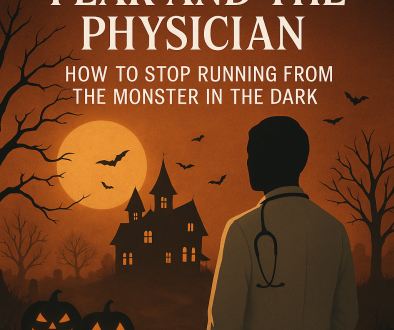The Science of Gratitude: How Neuroscience Changed My Perspective on Burnout and Joy
Beyond the Buzzword
It’s a concept we all know, often tossed around as a cure-all for stress, unhappiness, and burnout. For many of us in medicine, it sounds hollow. A nice idea, but not a fix for a broken healthcare system. But what if we’ve misunderstood gratitude all along? What if it’s not supposed to be a fix for the system. What is it is more than a fleeting emotion and rather is a biological mechanism that can reshape how we experience our lives?
My introduction to gratitude practices went something like this like this:
The session ended with a simple statement. “I want you to try something new this week.” I braced myself. I had already tried medications and CBT. The meds disrupted my sleep and the therapy was helpful but had run its course. I waited for what came next.
“Before you walk into work, think of something you are grateful for.”
I sighed. I was doubtful.
I had tried everything else. What did I have to lose.
That simple exercise sent me down an unexpected path. One that led into neurobiology and ultimately changed how I see my work and how I experience my life.
From Skepticism to Science
Like many of my physician coaching clients, I was skeptical. The idea that something as simple as “being thankful” could change the reality of my job felt naïve. The systemic pressures are real. The workload is real. The moral injury is real.
How could gratitude possibly compete with that?
Despite my doubts, I thought of three things I was grateful for every morning. Slowly, something shifted. I noticed I was a little less crusty, quicker with a smile, and in a better mood at the end of the day. Was this simple gratitude exercise responsible for the shift?
My curiosity, and my need for evidence, pushed me to look deeper. I started digging into the scientific literature, and what I found was astonishing. There’s a growing body of research that looks at gratitude not as sentimental fluff, but as a hard-wired biological mechanism with the power to reconfigure our neural circuits.
What the Brain Reveals About Gratitude
What I learned eliminated my doubt. When we experience true gratitude, not just writing a list, but actually feeling it through a vivid story or memory, key areas of the brain are activated. Specifically, the medial prefrontal cortex. This region is responsible for high-level thinking, for context, for perspective. In other words, gratitude was acting like a switch, moving my brain from a state of threat and anxiety to a state of connection and meaning.
Neuroscientists like Dr. Andrew Huberman and Dr. Antonio Damasio have shown that this isn’t just a passing mood. It’s a measurable physiological event. Levels of neurochemicals like serotonin and oxytocin, “feel good” and “bonding” chemicals, go up. At the same time, inflammatory markers such as IL-6 and TNF-alpha, which are associated with stress, anxiety, and depression, go down. Gratitude isn’t just an attitude. It’s biology.
Why Stories Matter More Than Lists
The most profound revelation for me wasn’t just that gratitude works. It was how it works.
The science is clear: the most effective gratitude practices are not about forcing yourself to write down three things you’re thankful for. They’re about story. They’re about narrative. The brain responds most powerfully when you recall a specific moment when you received genuine thanks from someone, when you felt blessed, or when you witnessed a meaningful act of gratitude. Then, you let yourself relive it. You don’t just think about it. You feel it.
This kind of narrative-based gratitude has been shown to create a far more potent shift in our neurochemistry and physiology than generic “gratitude lists.” It’s not performance. Rather, it’s recall and emotional memory.
Putting Gratitude Into Practice
So I began an experiment. A few times a week, for one to five minutes, I would close my eyes and recall a story of gratitude. Sometimes it was a patient’s heartfelt thank-you. Others, it was a note from a colleague at exactly the moment I needed to hear it. Occasionally, it was a story I’d heard about someone else’s act of appreciation. More often than not, it was something from the day that I was genuinely thankful for.
I didn’t just remember the event. I let myself feel it. The warmth. The connection. The sense of belonging to something larger than myself.
Slowly, almost imperceptibly at first, my internal landscape started to change. The lens I was using to interpret my day-to-day life began to shift. The daily frustrations were still there, but they didn’t dominate my inner dialogue. I started noticing small moments of connection and meaning that had always been present, but that my burned-out brain had stopped registering.
I was still a physician working in the trenches. But I no longer felt like a victim of my circumstances. I had found a tool, a scientifically supported, neurobiologically grounded tool, that helped me change my perception in real time.
Reframing Perception Through Gratitude
This, to me, is the real power of gratitude. It’s not about ignoring the negative or pretending things are fine. It’s about giving your nervous system access to a fuller picture and reminding your mind that connection, meaning, and purpose still exist alongside the pressure.
Gratitude showed me that perception isn’t fixed. It’s dynamic. It’s something we can actually train. We are not just passive observers of our own lives. We are active participants in shaping the way we experience reality.
Conclusion: A Simple Practice, A Powerful Shift
The science of gratitude offers more than comfort. It offers agency.
Through a simple, story-based practice, we can begin to rewire our brains, reduce stress, and reconnect with the reasons we do this work in the first place. It’s not a magic bullet. It won’t singlehandedly fix the healthcare system. But it might give you back a sense of presence, meaning, and belonging inside it.
And for those of us who have felt lost in the darkness of burnout, that small shift—that first trace of light—can make all the difference.





